The Art of Research
The Art of Research photo contest is aimed at providing a creative and accessible method of sharing the ground-breaking research being done by Queen’s community members and celebrating the global and social impact of this work.
The 2023 contest looked at research through the lens of the United Nations’ Sustainable Development Goals (SDG), a universal call to action. Universities are some of the world’s most powerful engines for driving positive social impact. By showcasing our research contributions to the SDGs, we emphasize our commitment to ensuring Queen’s is focused on these global goals – the hallmarks of which are community, sustainability, innovation, equity, and internationalization efforts.
Photo Galleries
Winners of the Art of Research Photo Contests: 2015 – 2023
Lithium Below, Stars Above
Dr. Christopher Spencer
Lithium is an element that is key to our energy transition away from fossil fuels and plays an important role in the battery technologies for space exploration. This photo was taken during an expedition to Western Australia exploring for lithium deposits that have the potential to reshape the global economy and resolve the global climate crisis.
Location of photograph:
Western Australia
Affiliation:
Faculty, Geological Sciences and Geological Engineering
Submission Year:
2023

Crystallization Pattern of a Common Salt Mixture
Rachel Korchinsky
Lithium-ion batteries (LIBs) are rechargeable energy carriers that power electronic devices such as phones, cars, and hybrid/electric vehicles. The demand for lithium used to manufacture LIBs is expected to grow 30-fold by 2040. Industry primarily extracts lithium from rock ore and brine; however, the methods used are time-intensive and costly. Therefore, we are investigating alternative extraction methods that would reduce the energy consumption, waste production, and time intensity. The image, obtained by microscopy, is of salts that crystallized after evaporation of a lithium-containing brine.
Location of photograph:
Electron Microscopy Facility, Queen's University
Affiliation:
Graduate Student, Chemistry
Submission Year:
2023

Returning the Gaze
Siobhan Speiran
This was taken by Rubén Vargas at the wildlife sanctuary Proyecto Asis in Costa Rica, who captures the most beautiful images of the resident animals. I am standing in front of the capuchin enclosure observing the behaviours of Lulo, Lucy, Soplita, Pablita, and Cappuccino, while guided tours are taking place nearby. It is illegal to own wild animals in Costa Rica; these capuchins have been rescued from their past lives as companion animals or entertainers. While unable to be reintroduced to the wild, they receive life-long care and advocacy in the sanctuary community. My research looks at the intersections of animal welfare and conservation in Costa Rican sanctuaries, which are popular sites of sustainable, captive wildlife tourism. Here, the monkey returns my gaze in this photo, blurring the distinction between researcher and subject; I study him while he studies me.
Location of photograph:
Proyecto Asis, Costa Rica
Affiliation:
PhD Student, School of Environmental Studies
Submission Year:
2023

Corneal Fingerprint
Cassandra Brand
The cornea is one of the most densely innervated tissues in the human body. The high presence of sensory nerve endings makes the cornea extremely sensitive to pain and changes at the eye’s surface. This is particularly important in regulating tear production, a function which is impaired in dry eye disease.
By analyzing changes in nerve patterns and ion channel expression, we aim to further clarify the role of corneal nerves in spontaneous pain and tear production in dry eye disease. This image shows the structural βIII-tubulin component of mouse corneal nerves at their unique convergence point.
Location of photograph:
Botterell Hall, Queen's University
Affiliation:
Graduate Student, Translational Medicine
Submission Year:
2023
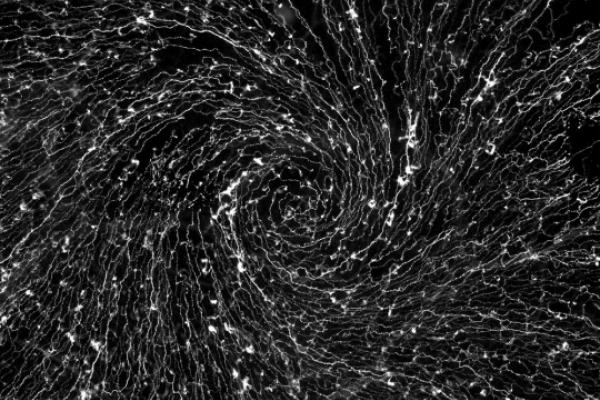
Inuit Nunangat: Where Two Worlds Collide (From the Art and Waste in Pannituuq [Pangnirtung] Project)
micky renders
Inuit Nunangat is a site where differing epistemologies and cosmologies collide. The Arctic waste crisis stems from a culture of wasting that is capitalist and not Inuit. With the delicate Arctic ecosystem degrading due to climate change, escalating resource extraction, the opening of the Northwest Passage, and the expansion of NORAD, unprecedented volumes of waste and contaminants are causing unknowable changes in life, land, sea, and ice. At the intersection of art, politics and activism, the Art and Wastes in Pangnirtung Project challenges assumptions about Inuit and exposes the pervasive nature of settler colonization as the root cause of wastes.
Location of photograph:
Pannituuq (Pangnirtung), Nunavut
Affiliation:
PhD Student, School of Environmental Studies
Submission Year:
2023
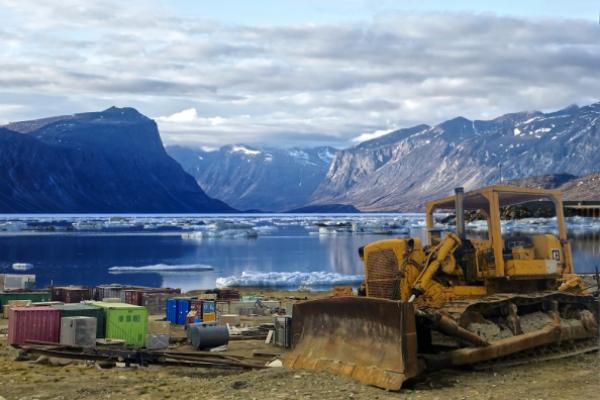
Frozen in Time: Unveiling the Mysteries of Turner Glacier through Glaciological Research in Akshayuk Pass
Wai Yin Cheung
Glaciological research on Turner Glacier in Akshayuk Pass involves studying the physical properties and behavior of the glacier, as well as the surrounding environment, to better understand the dynamics of this glacial system. This includes measuring yearly snowfall, melt, and ice thinning to understand ice volume change and sea level contributions over the past 50+ years. By collecting and analyzing data over time, Queen's ICELab glaciologists can identify patterns and changes in glacial behavior, which can inform our understanding of climate change and its impact on northern environments. The research on Turner Glacier is part of a larger effort to study glacial systems around the world and develop strategies for mitigating the effects of climate change.
Watch the full video: https://bit.ly/3MD00Vy
Location of photograph:
Turner Glacier, Akshayuk Pass
Affiliation:
PhD Student, Geography and Planning
Submission Year:
2023
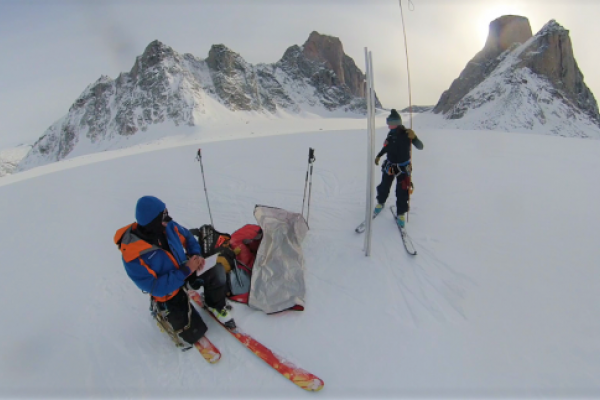
The SNO+ Detector
Alex Wright for the SNO+ Collaboration
The SNO+ experiment studies the fundamental properties of neutrinos. The detector consists of an active volume of 780 tonnes of liquid scintillator housed within a 12-metre diameter acrylic vessel that is held in place by ropes and viewed by an array of about 10,000 photomultiplier light detectors. In this image, taken by a camera embedded in the photomultiplier array, the detector is illuminated only by light from the clean room at the top of the vessel neck, producing a beam effect. The SNO+ experiment is currently collecting data, carrying on the work of the Nobel-prize winning Sudbury Neutrino Observatory.
Location of photograph:
SNOLAB, Sudbury, Ontario
Affiliation:
Faculty, Physics, Engineering Physics, and Astronomy
Submission Year:
2022
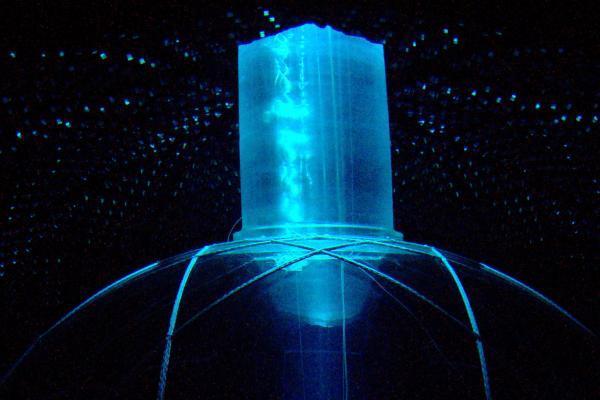
George Konana Collecting Ice
Saskia de Wildt
The Inuit practice an ongoing relationship with the land through camping, hunting, and fishing. As part of the BearWatch project, I explore how such knowledge, accumulated over many generations, and Inuit values can be ethically engaged in a community-based polar bear monitoring program. This picture is taken on one of our trips out on the land around Gjoa Haven during spring 2022. It captures George Konana collecting ice from the lake for tea. He traces ice with the right quality to give his tea a nice ‘reddish, brown’ color. At this exact moment, he cracks out a huge piece, enough for a month of tea.
Location of photograph:
Gjoa Haven, Nunavut
Affiliation:
PhD Student, School of Environmental Studies
Submission Year:
2022
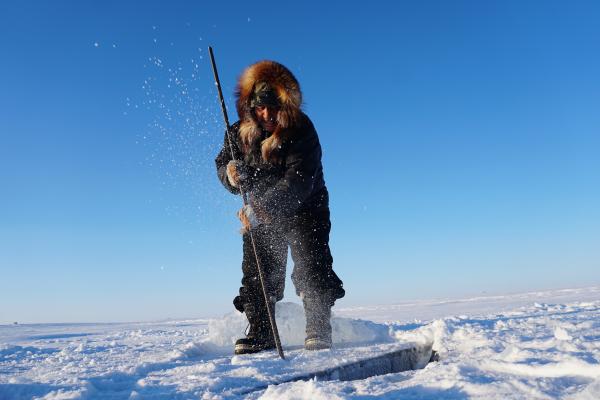
The Tiniest Tree of Life
Elahe Alizadeh, PhD
COVID-19, the second pandemic of the current century, is still an ongoing global health emergency. Its complications and mortality are associated with pneumonia and alterations in the pulmonary vasculature. Acquiring 3D images of vascular trees in animal models provide a useful tool to evaluate the effects of COVID-19 in humans. In our research aimed at finding new drugs for COVID-19 under the supervision of Dr. Stephen Archer, vascular trees of a mouse were pressure perfused to maximal dilation with a radio-opaque material (barium). The heart and lungs were fixed and scanned using VECTor4CT scanner. VECTor4CT is the first tri-modality imaging system equipped with an ultra-high-resolution micro-computed tomography (µCT) scanner at Queen’s University.
Location of photograph:
Queen's CardioPulmonary Unit (QCPU)
Affiliation:
Queen’s CardioPulmonary Unit (QCPU), Department of Medicine
Submission Year:
2022

Aging with Oasis
Riley Malvern
Oasis is a program co-developed by older adults to strengthen and sustain their communities to support aging in place. The Oasis Evaluation and Expansion research team has been working with Oasis communities since 2018 to expand the program across Canada and to evaluate a number of health and well-being outcomes. This photo depicts a mural that represents the power of communities coming together. Each square of this mural was designed by an Oasis member from communities across Kingston and Belleville. Together, these squares form the Oasis logo, which was designed by members of the original Oasis community.
Location of photograph:
Kingston, Ontario
Affiliation:
Staff, Health Services and Policy Research Institute
Submission Year:
2022

Crystalline Acid
Dan Reddy
This photo taken with scanning electron microscopy depicts an extremely small yet precise volume (i.e., nanolitre-sized) of crystallized decanoic acid. We are using these spots of crystalline acid to extract and preconcentrate, or soak-up, chemicals of concern like opioids from wastewater samples. This preconcentration step improves our ability to monitor these chemicals. By doing so, we can improve how we detect these harmful compounds and protect local watersheds.
Location of photograph:
Chernoff Hall, Queen's University
Affiliation:
PhD Student, Chemistry
Submission Year:
2022
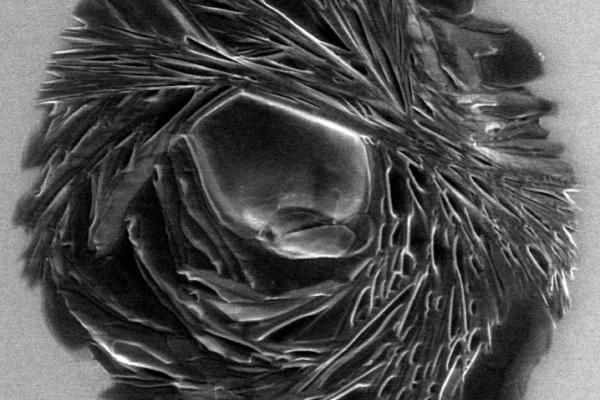
Polar Bear Denning
Scott Arlidge
This photo demonstrates the collection of snow from inside a maternal polar bear den to collect environmental DNA. When the mother digs out the den, skin cells from its paws are abraded and stuck to the snow. Some preliminary research shows that we may be able to identify individual bears by analyzing these snow samples, information which can inform polar bear population management. My research is a pilot of ground-based non-invasive polar bear monitoring techniques, with a focus on Inuit inclusivity. Inuit Elders and polar bear hunters were key knowledge holders and collaborators throughout this research.
Location of photograph:
Coral Harbour, Nunavut
Affiliation:
Graduate Student, School of Environmental Studies
Submission Year:
2022

Gastropod Mummy
Ruqaiya Yousif
This is a picture of a gastropod mummy laying down her egg cases. My research is to assess the stable isotope (C and O), clumped isotope (∆47), and trace element compositions of living and Quaternary shells from the Arabian/Persian Gulf. The aim is to link these analyses with modern oceanographic data to develop a robust proxy for understanding oceanographic change in the rock record. In simple terms, I am trying to link the shell chemistry with its surrounding environment and then use this link to assess oceanographic changes in the past 125K year. At the time of this picture, we were growing gastropods under laboratory conditions and performing in vitro fertilization of oysters.
Location of photograph:
Qatar
Affiliation:
PhD Student, Geological Sciences and Geological Engineering
Submission Year:
2022

Porous Plastic Particle
Ross Jansen-van Vuuren
The photograph is of a water-swollen hydrogel particle created in our chemistry laboratory, taken with an instrument called a Scanning Electron Microscope, which allows us to zone in and see important details on the surface of the hydrogel. A hydrogel is essentially a plastic material that is able to absorb very large volumes of water (up to 800 times its weight!) – much like a baby diaper, swelling as it does so. From the image, the surface of the hydrogel is seen to possess large, distinctive pores, which help us understand how and why hydrogels absorb so much liquid.
Location of photograph:
Bruce Hall, SEM Lab, Queen’s University
Affiliation:
Post-Doctoral Fellow, Chemistry
Submission Year:
2019-20

Nature’s van Gogh
Hayden Wainwright
Algal blooms appear as smears of green slime from the ground, but are beautiful pieces of abstract art from an aerial view, painted by wind and sunlight. My research takes me to lakes on the Canadian Shield affected by blooms, where I photograph them with a drone while assistants help me collect water samples. By uncovering when, where, and why they appear, we hope to restore some of Canada’s most beautiful lakes to their pristine states.
Location of photograph:
South Frontenac County, Ontario, Canada
Affiliation:
Graduate Student, Biology
Submission Year:
2019-20
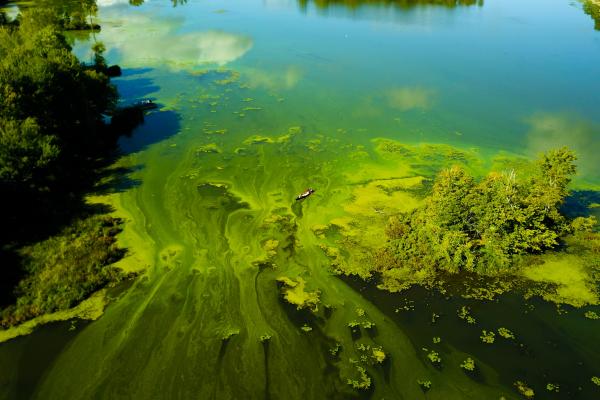
The Wiring of the Brain
Donald Brien
An example of Diffusion Spectrum Imaging (DSI) from Queen’s new Prisma Magnetic Resonance Imaging (MRI). Some of the most beautiful images generated by MRI are created by imaging the diffusion (movement) of water throughout the brain. From this diffusion, we can generate maps of the neuron connections that are responsible for carrying messages from one area of the brain to another. Seen here, they are coded by direction, such that blue tracts move from foot to head, red tracts move from left to right in the head, and green tracts move from the front to the back of the head. There are 30,000 tracts displayed in this image. By adulthood, the average person has ~160,000 km total length of these tracts.
Location of photograph:
Centre for Neuroscience Studies, MRI Facility, Queen’s University
Affiliation:
Staff, Centre for Neuroscience Studies
Submission Year:
2019-20

Learning from the Land
Sarah Flisikowski
The transmission and documentation of traditional knowledge and skills is of great importance to Inuit, especially considering the continuing social, environmental, and economic changes in the Arctic. I am examining how Inuit traditional knowledge is generated and shared through a case study of an existing project in Ulukhaktok called Nunamin Illihakvia, which means "learning from the land" in Inuinnaqtun. Participants from other Inuvialuit communities were invited to travel to Ulukhaktok in February 2020 to participate in cultural activities that promoted discussion on what a cultural learning program should include. This photo shows our first trip out on Queen's Bay together.
Location of photograph:
Ulukhaktok, Northwest Territories, Canada
Affiliation:
Graduate Student, School of Environmental Studies
Submission Year:
2019-20

A Glance in the Brain
Natalia de Menezes Lyra e Silva
The primate brain is highly specialized, allowing us an incredible range of experiences. This microscopic photo captures cells within a brain region, the hippocampus, involved with learning and memory. Every lived experience that we are able to remember has boosted the formation of new connections in our brains. These connections are affected in diseases that impair memory, such as Alzheimer's disease (AD). Here, we can observe cells involved with the brain inflammatory response. These cells are upregulated in the brains of AD patients. This technique allows us to better understand how our brains work and how they are altered by diseases.
Location of photograph:
Centre for Neuroscience Studies, Queen's University
Affiliation:
Post-Doctoral Fellow, Centre for Neuroscience Studies
Submission Year:
2019-20
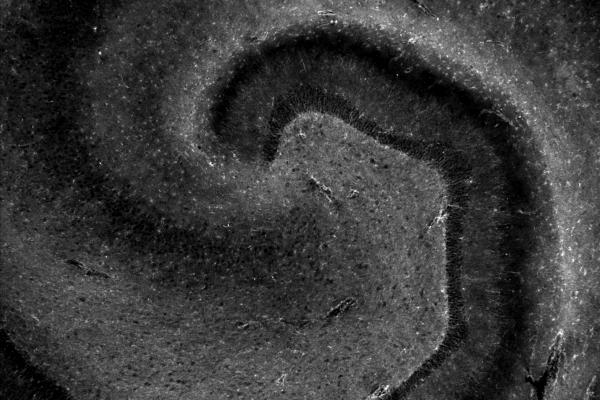
Under the Umbrella
Grace Adeniyi-Ogunyankin
On a very hot day, I went to the Adelabu Market in Ibadan, Nigeria, to meet Sarah. Several phone calls later, we found each other. She brought me inside a nearly abandoned plaza. “Less noisy,” she said. We climbed up to the highest floor. During the interview, she told me her livelihood as a market woman funded her children’s education. Rain or shine, she is at the market every day, under her umbrella. When we finished the interview, I looked down. What a view! As I snapped a photo, I wondered: “What are the stories of the other people under the umbrellas?”
Location of photograph:
Ibadan, Nigeria
Affiliation:
Faculty, Gender Studies; Geography and Planning
Submission Year:
2019-20

This is EPIC: Simulation Education with Patient Actors to Improve Care
Monakshi Sawhney
Simulation education, using standardized patient actors, is a unique way to provide education in health care settings to practicing clinicians. It is an opportunity to practice assessment skills and critical thinking in a safe environment that mimics the patient care setting. Our team implemented this concept at a hospital in Toronto, with a focus on researching the outcomes of a simulation intervention for nurses who care for patients receiving epidural analgesia for pain management after surgery. This photograph depicts the real-to-life patient care environment that was created for this study.
Location of photograph:
Education and Research Centre, North York General Hospital, Toronto, Ontario
Affiliation:
Faculty, School of Nursing
Submission Year:
2019-20
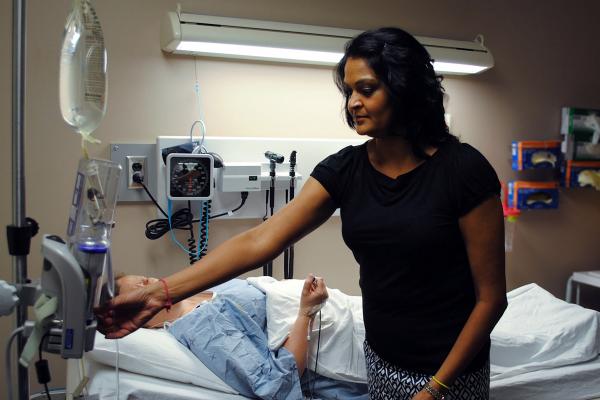
Shattered Planet
Allen Tian
The impact of human activity on our planet is often difficult to see in the moment, and requires a long-term, overlooking, view. This photo is a drone panorama of my field site on the Rideau Canal System, where I investigate the impact of human activity on aquatic ecosystems, particularly the development of toxic algal blooms. Activities such as fishing, property development and farming have fragmented and altered this ecosystem, and we need a holistic, broader view to piece together how we can protect our delicate, beautiful, world.
Location of photograph:
Milburn Bay, Dog Lake, South Frontenac County, Ontario, Canada
Affiliation:
Graduate Student, Biology
Submission Year:
2019-20
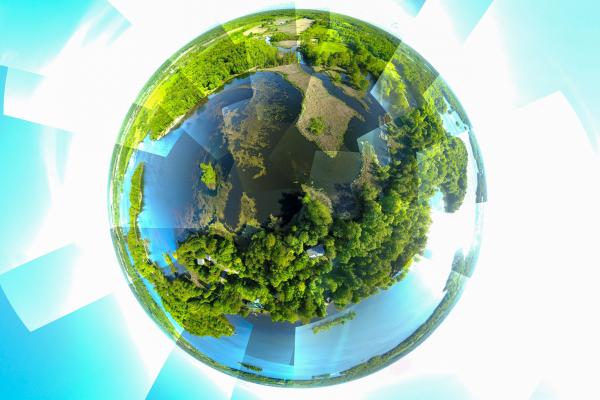
Researchers at Offroad Robotics
Heshan Fernando
A group of multidisciplinary engineering researchers with expertise in mining and construction applications, mechanical and mechatronics systems, as well as electrical and computer engineering collaborate to develop the next generation of field and mobile robots.
Location of photograph:
Jackson Hall, Queen’s University
Affiliation:
PhD Student, Mechanical and Materials Engineering
Submission Year:
2019-20
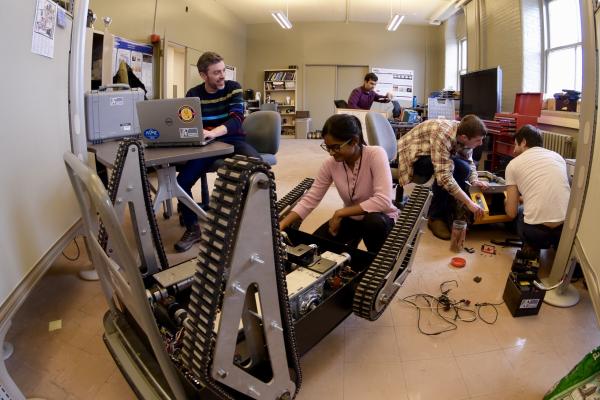
Propelling Research
Lauren Welte
Our feet make contact with the ground millions of times within our lifetime, yet we still do not completely understand how they function. Using dynamic X-ray video, we image foot bones in ways we could only previously imagine. Recent work has questioned several popular theories about soft tissue function in the arch. Ongoing research aims to understand healthy foot function, to better inform treatments for foot pain. This research has the capacity to propel our understanding of foot function forward.
Location of photograph:
Skeletal Observation Laboratory, Queen’s University
Affiliation:
PhD Student, Mechanical and Materials Engineering
Submission Year:
2019-20
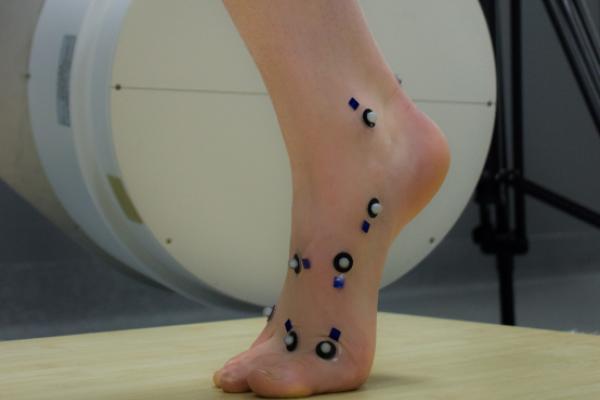
Love Under the Microscope
Dalila Villalobos
As pathologists in training, we are constantly reminded that both human cellular responses and the most deadly medical conditions can be unexpectedly beautiful under the microscope.
We are trained to be detail oriented and to understand disease in all its forms because abnormalities will only present to the eye that knows what to look for.
This photo captures a normal prostatic gland with its characteristic double layer and irregular branching.
The moment we diagnose a benign condition in a patient that is anxiously awaiting results is always rewarding. But, if, on top of that, we see heart-shape glands, it is inspiration.
Location of photograph:
Kingston Health Sciences Centre
Affiliation:
MD, Resident, Anatomical Pathology
Submission Year:
2018-19
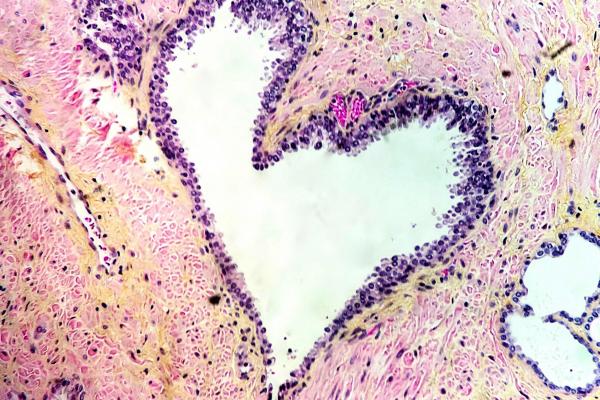
Keep Cool Boy - The Jets Aloft in West Side Story
Tim Fort
In a rare moment, before a Franz Kline-inspired setting, the Jets achieve a perfectly synchronized lift-off in this production of West Side Story mounted in celebration of Leonard Bernstein's 100th birthday. After forty-six seasons at the Weston Playhouse in Vermont, this production also represented my 60th (and final) happy entanglement directing mostly musical theatre works on the playhouse's historical stage. Twenty-seven performers – from newly minted conservatory graduates to Broadway veterans – enabled this epic work to fly.
Location of photograph:
Weston Playhouse, Vermont
Affiliation:
Faculty, Dan School of Drama and Music
Submission Year:
2018-19

Nano-dendrite Collision
Hannah Dies
This scanning electron microscopy image depicts branched gold nanostructures (“nano-dendrites”) growing from planar microelectrode tips and crashing halfway, buckling upwards to create a third dimension of nano-features. The structures assemble from gold nanoparticles under the influence of an applied electric field, similar to how iron filings assemble under the influence of a magnetic field. The gold nanoparticle building blocks are 50nm in diameter – about 5000 times smaller than a human hair. The branched network formed by these nanostructures promotes incredible sensitivity for small molecule detection by means of Raman spectroscopy. At the QuSENS laboratory, and with the startup company Spectra Plasmonics Inc., we use these nanostructures to detect illicit drugs, pesticides, and explosives at ultralow and societally relevant concentrations.
Location of photograph:
Dupuis Hall, Queen's University
Affiliation:
MD/PhD Student, Chemical Engineering
Submission Year:
2018-19

A New Light
Robert Cichocki
Tired of seeing roads being dug up to replace aging pipe infrastructure? Civil engineering research at Queen’s is bringing a new light to innovative, no-dig rehabilitation techniques. In this image, a UV light train is being prepared to help rehabilitate the adjacent corrugated steel pipe. The inside of the pipe has been lined with a fabric fibreglass tube embedded with UV cure resin. When the light train passes through the tube, the UV cures the resin solid and transforms the fabric tube into a solid liner. The new liner and pipe will further undergo buried experiments that will bring new insight into the structural behaviour of these systems.
Location of photograph:
GeoEngineering lab, Queen's University
Affiliation:
PhD Student, Civil Engineering
Submission Year:
2018-19
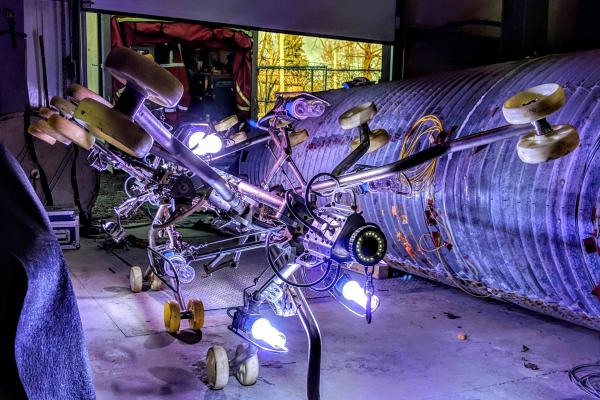
Learning to Live (Not Walking in Line)
Theodore Christou
The history of research and scholarship in education is a record of our efforts to make sense of the world.
How ought we to live? What should we learn, embrace, and resist?
From antiquity to anarchism, or, from Aristotle to Pink Floyd, we have known that we should never confuse schooling with education. Schools, whether they are traditional, progressive, colonial, or transgressive, have all been instruments of oppression as well as resistance.
Location of photograph:
Wall graffiti in Thessaloniki, Greece
Affiliation:
Faculty, Faculty of Education (Cross-appointment, History)
Submission Year:
2018-19

Lights, Camera, Action: Wolfie's Story
Marian Luctkar-Flude
"Lights, Camera, Action: Wolfie's Story" is a photo depicting the filming of a virtual simulation game about an older gay man grieving the loss of his partner of over 30 years. The game is part of the "Make it Better for All" Developing and Evaluating Sexual Orientation and Gender Identity Nursing Virtual Simulation Games project, led by Dr. Marian Luctkar-Flude, an assistant professor in the School of Nursing. This innovative CIHR-funded research project aims to develop and evaluate a series of virtual simulation games to provide education for nurses and nursing students on Sexual Orientation and Gender Identity (SOGI). Four full games and four mini-games will be hosted on the SOGI-Nursing website along with other resources to promote cultural humility in nursing interactions with LGBTQI2S persons. The research project will evaluate the pedagogical value of using virtual simulation games to educate nurses and nursing students.
Location of photograph:
Glaxo Wellcome Clinical Education Centre, Queen's University
Affiliation:
Faculty, School of Nursing
Submission Year:
2018-19
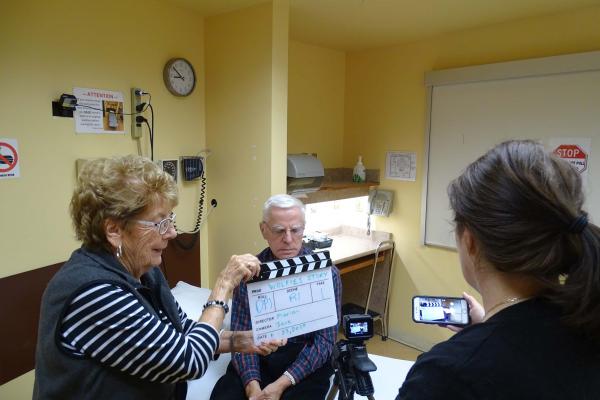
First Emergence
Ivana Schoepf
My research focuses on the effects that avian malarial parasites have on female reproductive success and offspring quality. To assess how malarial infection affects mothers and their offspring, I spent the spring and summer in the field at the Queen's University Biological Station catching female, adult red-winged blackbirds and treating them with either an antimalarial medication or a control solution. Female reproductive success was determined by looking at a variety of parameters, including incubation behaviour, which was measured using I-buttons (as seen in the photo). If experimental reduction of infection leads to higher reproductive success in females, I expected to find medicated females to be able to spend more time incubating their eggs. Our preliminary analysis shows that this is indeed the case.
Location of photograph:
Queen's University Biological Station
Affiliation:
Post-Doctoral Fellow, Biology
Submission Year:
2018-19
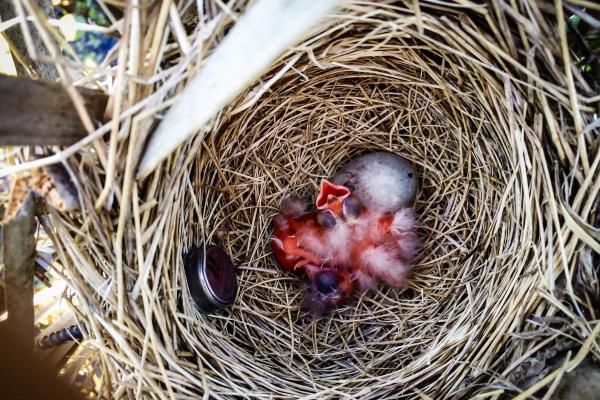
Women in Mathematics
Stefanie Knebel
Mathematical thinking is about finding patterns and structure. As a woman in the mathematics PhD program, I hope to inspire young women to follow their passion and find beauty in mathematics. At Queen’s, we offer the MathQuest camp for high school girls. As captured in the photo, I am brainstorming ways to teach game theory and linear algebra. This is also a part of my research with Dr. Peter Taylor, working with teachers across Ontario to look for innovative ways to incorporate mathematical thinking in education. We hope to change the math curriculum by making it a more engaging, positive, and memorable experience.
Location of photograph:
Jeffrey Hall, Queen's University
Affiliation:
PhD Student, Mathematics and Statistics
Submission Year:
2018-19
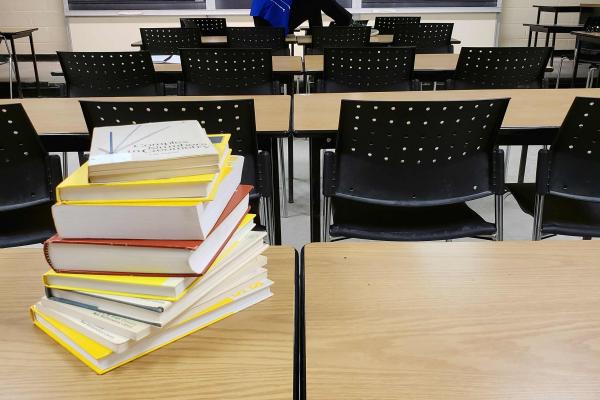
Biomimetic Scaffolds
Fei Chen
The Anterior Cruciate Ligament (ACL) of the knee joint, one of the strongest ligaments of the body, is also the target of traumatic injuries. Once injured, its healing potential is limited. The ACL mainly consists of packed and thick collagen fibres oriented along the long axis in a wavy pattern, and this unique wavy pattern is essential for providing load-bearing protection to the knee joint. This SEM image shows a bioengineered fibrous scaffold made from synthetic biomaterials with a wavy pattern, with amplitudes and wavelengths similar to the collagen fibers present in a native ACL.
Location of photograph:
Dupuis Hall, Queen’s University
Affiliation:
Staff, Chemical Engineering
Submission Year:
2017-18

Unspooling Vermeer
Stephanie Dickey
Wherever I go, I look for evidence of how the historical art I study impacts visual culture today. In “After Vermeer 2,” an installation from 2006 by New York artist Devorah Sperber, 5024 spools of thread strung on steel chains recreate, upside down, the famous “Girl with a Pearl Earring” painted by Dutch artist Johannes Vermeer around 1665. My photo captures the viewer’s experience of looking through a glass sphere in which the image rights itself. Vermeer, whose paintings explored both optics and female experience, would surely have appreciated this perceptive transformation of his art.
Location of photograph:
Kimmel Center, Philadelphia, USA
Affiliation:
Faculty, Art History and Art Conservation
Submission Year:
2017-18
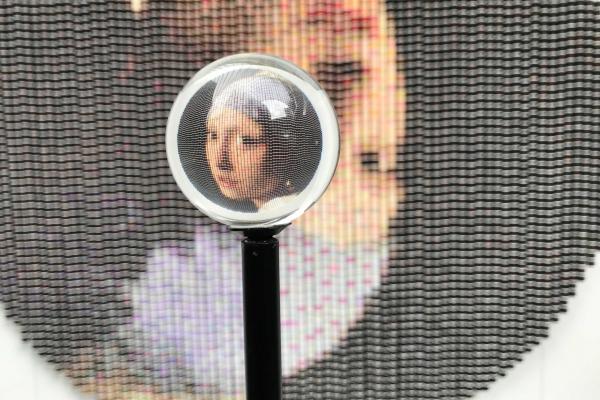
Window on a Window to the Universe
Mark Chen
An underwater camera mounted in the SNO+ (Sudbury Neutrino Observatory) neutrino detector captures a snapshot image when the 12-metre diameter acrylic sphere is 85% full. Viewed from below, ropes are seen crisscrossing the top of the sphere extending down (foreground), and each of the shiny cells that are visible is a 20-cm diameter super-sensitive light detector. The water-air interface inside and outside the acrylic spherical tank creates visual distortions as light refracts at the optical boundary. Once full, the upgraded detector turns on in Fall 2016, ten years after the original SNO detector completed its Nobel-prize winning studies.
Location of photograph:
SNOLAB, Sudbury, Ontario
Affiliation:
Faculty, Physics, Engineering Physics and Astronomy
Submission Year:
2016-17
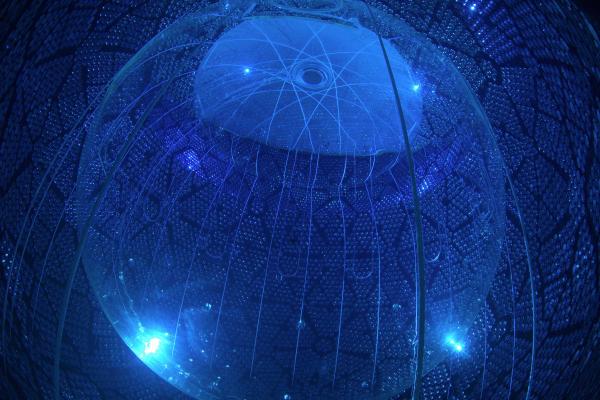
Santa Fina
Una D’Elia
Pietro Torrigiani, a competitor of Michelangelo, carved this bust of a saint out of marble and then painted it so that blood seems to run in this determined young girl's veins. This lively piece, made over five hundred years ago, is an example of the kind of naturalistic sculptures that have been little studied, as most scholars focus on monochrome "high art" statuary. The sculptures I am studying were not confined to museums, but were a part of the social lives of Italian men and women, who talked to, touched, kissed, worshipped, attacked, and dressed sometimes uncannily realistic coloured sculptures.
Location of photograph:
Musei Civici, San Gimignano, Italy
Affiliation:
Faculty, Art History and Art Conservation
Submission Year:
2015-16
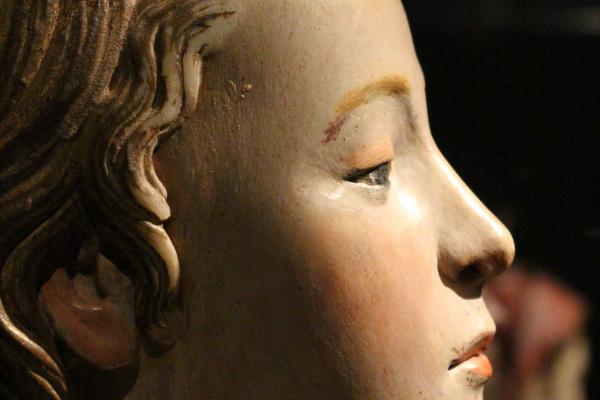
“Non-wetting” Water
Timothy Hutama
This drop sits on a super-hydrophobic surface that is unable to become wet because its affinity to water is less than what water has for itself. Therefore, water forms small, easily movable drops on the surface rather than a single puddle. While these surfaces have been used to keep cities free from graffiti, the Oleschuk group’s research involves using these surfaces in creative ways, such as the determination of beer’s alcohol content or to provide a platform that uniquely manipulates drops using magnets to miniaturize analytical chemical methods.
Location of photograph:
Chernoff Hall, Queen's University
Affiliation:
Graduate Student, Chemistry
Submission Year:
2016-17

Magdalene
Una D’Elia
For over 550 years, the passionate Magdalene has been running with her veil streaming behind, screaming, to the body of Jesus, dead on the ground. This life-size statue, originally painted to mimic flesh and clothes, pushes the limits of the medium, terracotta. Renaissance men and women could walk among Niccolo dell’Arca’s sculptures, feeling as if they were present at this terrible moment in Christian history. Dr. Una D’Elia’s research focuses on such living sculptures, stories of statues coming to life, and people touching, dressing, attacking, and generally treating sculptures as if they were alive.
Location of photograph:
Church of Santa Maria della Vita, Bologna
Affiliation:
Faculty, Art History and Art Conservation
Submission Year:
2016-17

Amphibian from the Inside
Rute Clemente Carvalho
The evolutionary process called miniaturization can lead to morphological changes in body structures. The internal morphology of tiny specimens can be seen/observed using a special staining technique. This method digests the muscles, making them transparent, and colours the bones and cartilages. In the case of this froglet, it has a body size of around 18mm, and features like osteoderms in the skin and hyperossification on the skeleton can be observed. The knowledge of morphological structures can help researchers understand the evolution of the species’ behaviour and ecology of the species, and its phylogenetic relationships with related species.
Location of photograph:
Zeiss stereomicroscope in the laboratory
Affiliation:
Post-Doctoral Fellow, Biology
Submission Year:
2016-17

5000m High Sunset in the Andes
Chris Grooms
Lake Sibinacocha is the 22nd highest lake in the world. Storms from the Amazon push up over the mountains, depositing snow on icecaps feeding high elevation lakes. Andean societies are among the most vulnerable to the impacts of climatic change on freshwater systems. Climate change will exacerbate water quality and quantity problems affecting millions of people. Warming in the Andes is occurring at rates nearly twice the global average. The effects on Andean lakes and ecosystems remain largely unknown, despite their importance to people and biodiversity. The objective of Grooms’s research is to assess the impacts of climate change on lakes.
Location of photograph:
Lake Sibinacocha, Cusco, Peru
Affiliation:
Staff, Biology
Submission Year:
2016-17

Tulugak on the Crucifix
Norman Vorano
Dr. Norman Vorano was conducting historical research with Inuit elders in Nunavut in April and May of 2016. One woman recounted the loss of cultural traditions as a result of the changes that happened during the twentieth century, particularly from residential schools, the missionaries, and the waves of southerners who flooded into the Arctic after the Second World War. After they broke for lunch, Vorano stepped outside. The white sky was indistinguishable from the ground. He walked past a towering crucifix erected behind the Catholic Church, on an imposing hill overlooking the community. A raven flew down from the ethereal sky, perched on the Crucifix, and began vocalizing. For Western culture, the raven is a harbinger of death. For Inuit culture, tulugak – raven – is a tricky fellow that symbolizes creation.
Location of photograph:
Pond Inlet, Nunavut
Affiliation:
Faculty, Art History and Art Conservation
Submission Year:
2016-17

Aldonza
Tim Fort
This moment arrives at the end of the staging for the musical number "Aldonza" from The Man of La Mancha – one of two musicals Dr. Tim Fort directed at the Weston Playhouse in Vermont in the summer of 2016. Many of the show's creative team are Broadway veterans, including the designer and the performer playing Aldonza – whose character is pictured ignoring the aggressions of the muleteers as they sing to her in this musical version of the Don Quixote story. Dr. Fort’s research interests lie in lighting and staging, and he has been a producing director at the Weston Playhouse for the past 30 years.
Location of photograph:
Mainstage, Weston Playhouse, Vermont
Affiliation:
Faculty, Dan School of Drama and Music
Submission Year:
2016-17

Perfusion of Light
Raymond Sturgeon
This perfusion array allows quick changing of solutions. Solutions with different drugs are applied while recording the bioelectrical activity of nerve cells. The handmade array, roughly the size of a matchbook and very fragile, is essential for determining drug effectiveness at the level of a single protein’s function. I used a dual-light source to construct it using fine tubing, super-glue, wax, and half-millimetre glass barrels.
Location of photograph:
Botterell Hall, Queen's University
Affiliation:
PhD Student, Biomedical and Molecular Sciences
Submission Year:
2015-16
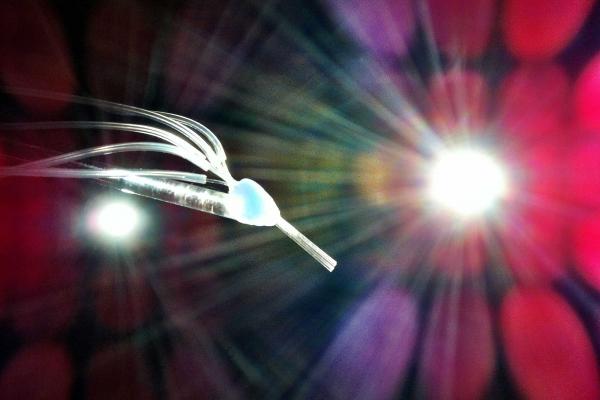
Evelyn Mitchell and her “Burler”
Laura Murray
Through oral history and archival research, the Swamp Ward and Inner Harbour History Project is revealing the twentieth-century history of two of the oldest neighbourhoods in Kingston, Ontario. Evelyn Mitchell worked at Hield Brothers Woolen Mill in the 1950s when she first arrived in Kingston from Yorkshire. In her interview, she describes in great detail the process by which she did “invisible mending” on the cloth coming out of the looms, picking out and pushing through loose threads. Here she displays the tool she used, a “burler,” which she has saved to this day.
Location of photograph:
Kingston, Ontario
Affiliation:
Faculty, English Language and Literature (Affiliated with Cultural Studies)
Submission Year:
2016-17

Phantasie Ist Alles
Julia Partington
Although I am an English major, I also study other languages and was fascinated by this piece of graffiti that I found on Museum Island in Berlin. Translated from German to English, it says, “Imagination is everything, it is the preview to the coming events of life.” This was said by Albert Einstein, and while his discipline is physics, different from mine, we both see the beauty of creativity. His creativity is in the stars, and mine is in language and literature. Arts and science are bound together in this short expression. A treasure waiting on Museum Island for me to embrace and understand.
Location of photograph:
Museum Island, Berlin, Germany
Affiliation:
Undergraduate Student, English Language and Literature
Submission Year:
2016-17

Polypyrrole
Danesh Roudini
The film morphology of electrochemically synthesized conducting polymers is widely dependent on electropolymerisation conditions. Some factors, like type of anions, solvent, and deposition rate, have a great influence on the final polymer quality and morphology. The SEM image shows electrochemically synthesized polypyrrole film on platinum electrode. Polypyrrole has high electrical conductivity and good environmental stability and has potential applications such as sensors, electrodes for rechargeable batteries, corrosion-protecting materials, electrochromic devices, and membranes.
Location of photograph:
Kingston University, UK
Affiliation:
Faculty, Bader International Study Centre - BISC
Submission Year:
2016-17
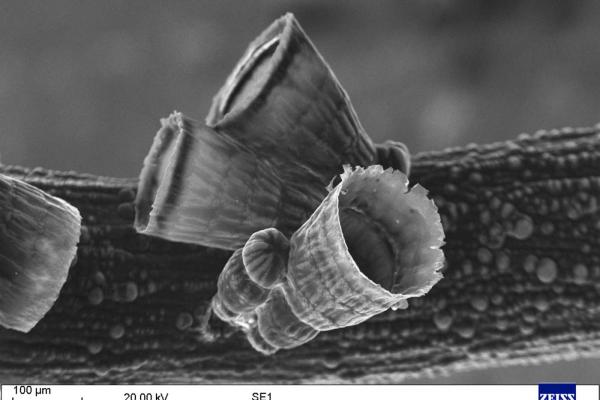
Gemini Mirror Reflections
Stéphane Courteau
The Gemini telescope and dome are ablaze in the setting sun's golden light. The reflections on the 8-m monolithic primary mirror are especially intricate and distorted. The shadow of the extinct 4200m Mauna Kea volcano can also be seen in the background upon a sea of clouds over the city of Hilo. The vertical shutters around the dome are usually opened at sunset to ensure that the inside and outside temperatures are the same throughout the night for greater image stability. Dr. Courteau has made extensive use of this telescope, and its twin in Chile, since his arrival at Queen's in 2004.
Location of photograph:
Mauna Kea, Hawaii
Affiliation:
Faculty, Physics, Engineering Physics and Astronomy
Submission Year:
2015-16
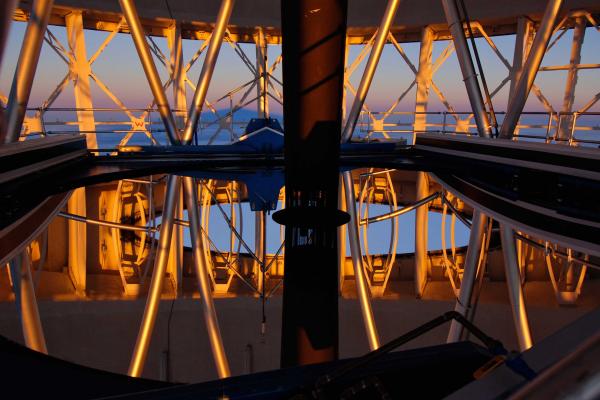
In Search of Byzantium
Theodore Christou
As an educational historian, my search for Byzantium (330-1453) led me to the remote monastic communities of Mount Athos. Since the 9th century, 20 Orthodox Christian communities have developed and currently reside there. These monasteries have preserved libraries, with holdings between 15,000 and 60,000 monographs. While access to Athos is highly restricted, typically to four days, I spent 12 days here working in five monastic libraries. I held and photographed several dozen texts that were otherwise ‘lost to the world’, and I lived the monastic life throughout my time spent there. Here is the monastery of Simonopetra. The library is in the lower level, near the promontory’s edge.
Location of photograph:
Simonopetra Monastery, Mount Athos
Affiliation:
Faculty, Faculty of Education (Cross-Appointment, History)
Submission Year:
2015-16
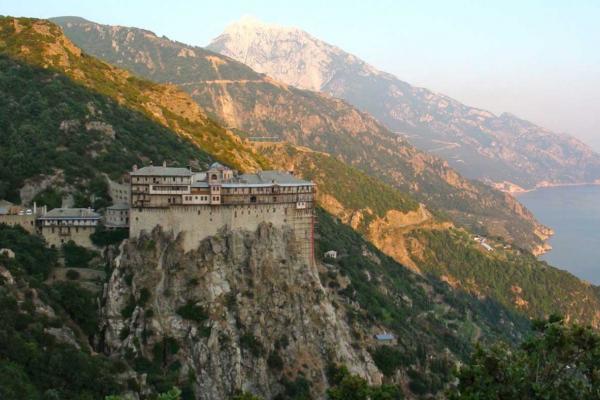
At a Snail’s Pace
Alamjeet Kaur Chauhan
This is a picture of the sea snail, Aplysia californica or California sea hare, which is widely used to examine how the activity of nerve cells evokes fundamental behaviours. I study how cation channels, which are specialized proteins that form pores allowing charged molecules in and out of the nerve cell, influence cellular activity. I use electrophysiology and molecular biology to study the reproductive behavior of Aplysia. My research is focused on studying the effects of reactive oxygen species on cation channels, which dictate reproduction in bag cell neurons of the snail.
Location of photograph:
Botterell Hall, Queen's University
Affiliation:
Graduate Student, Biomedical and Molecular Sciences
Submission Year:
2015-16

The Last Tree
Courtenay Jacklin
CCNF15: Clear Creek North Forest #15, otherwise known as the last tree. After three summers of field work and countless hours spent hiking to various study sites situated in the Kluane Region of the Yukon, Katherine finally takes the last tree core she will need to complete her project analyzing alpine vegetation dynamics. Using an increment borer to drill a small hole near the base of each tree, Katherine extracts a core which we store inside straws until returning to the lab. The annual growth rings along each core can be measured to gather information on growth and climate.
Location of photograph:
Southwest Yukon
Affiliation:
Undergraduate Student, Biology
Submission Year:
2015-16
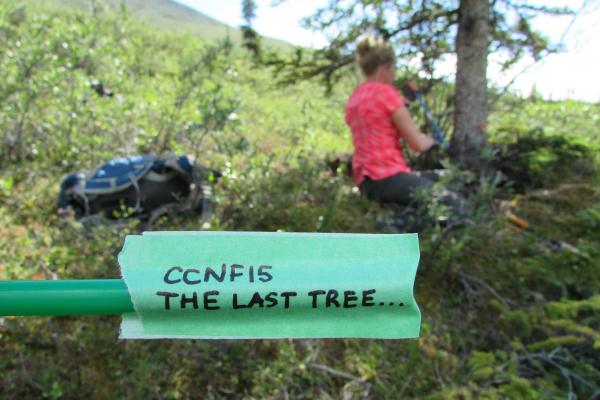
Buried Alive
Melanie Jansen
This photo was taken during my fieldwork, 2.5km underground in a platinum mine owned by Impala Platinum in Rustenburg, South Africa. Rather than a unique depiction, this photo is representative of the industry as a whole. It demonstrates the harsh realities mine workers face, subject to social, environmental, and economic challenges. Day-shift workers may spend up to six months at a time without ever seeing sunlight, their lives literally passing them by. Few opportunities exist for these men and women to break free of the dark, unforgiving platinum industry. The “X” is symbolic of this eventual cause of death, either directly or indirectly.
Location of photograph:
Impala Platinum Mine, Shaft #14, Rustenburg, South Africa
Affiliation:
Graduate Student, School of Environmental Studies
Submission Year:
2015-16

Inside Concord Floral
Naseem Loloie
Under the heat of the lights, covered in a stranger’s clothes, surrounded by the sights and sounds of the stage – this is when the actor’s transformation comes to life. During Theatre Kingston’s production of Jordan Tannahill’s Concord Floral, the audience and actors are seated inside an abandoned greenhouse – or at least, a stage mimicking a greenhouse through set design by Sean Mulcahy and lighting by Jennifer Lennon. As both an actor and an assistant director in this production, Naseem’s research focuses on costume, lighting, set and staging, and their transformative effects on the actor’s experience as they become a character.
Location of photograph:
Isabel Bader Centre for the Performing Arts, Queen's University
Affiliation:
Undergraduate Student, Dan School of Drama and Music
Submission Year:
2017-18
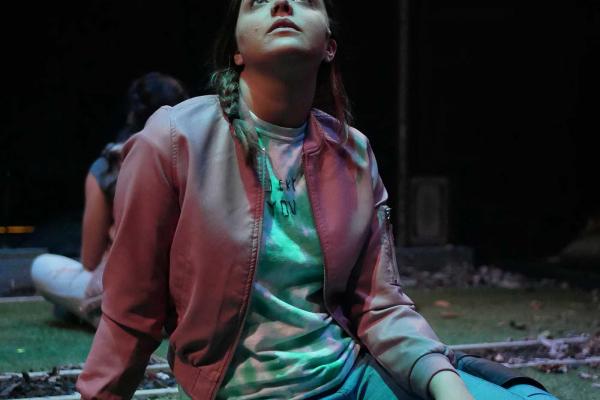
Landscapes of Resistance
Alexandra Pedersen
As a feminist/activist geographer, much of my doctoral research has concentrated on Indigenous and non-Indigenous communal experiences of violent development in Guatemala. An emblematic case of community conflict with, and resistance to, transnational corporate interests comes from the remote community of Lote Ocho. There, Irma Yolanda Choc Cac (pictured here) is one of eleven Indigenous Q’eqchi’ Maya women pursuing a civil court case against the Canadian mining company HudBay Minerals for sexual assaults allegedly committed during a violent eviction of her community from their ancestral lands in 2007.
Location of photograph:
Lote Ocho, Izabal, Guatemala
Affiliation:
PhD Student, Geography and Planning
Submission Year:
2017-18

Platinum Surface Electrochemistry
Derek Esau
The single crystal of platinum gently hangs atop an electrolyte surface. Electrochemistry is a surface-sensitive field of research, as the composition and atomic arrangement of the electrode drastically affect its properties. Atoms in a single crystal are highly ordered, and we are able to cut and polish a crystal in such a way that we only expose one of the many possible surface arrangements. The single crystal electrode is balanced on the surface of the electrolyte to ensure that only the polished surface is exposed. These experiments give us fundamental information about electrochemical reactions, which are integral to the field of clean energy.
Location of photograph:
Department of Chemistry, Queen's University
Affiliation:
PhD Student, Chemistry
Submission Year:
2017-18
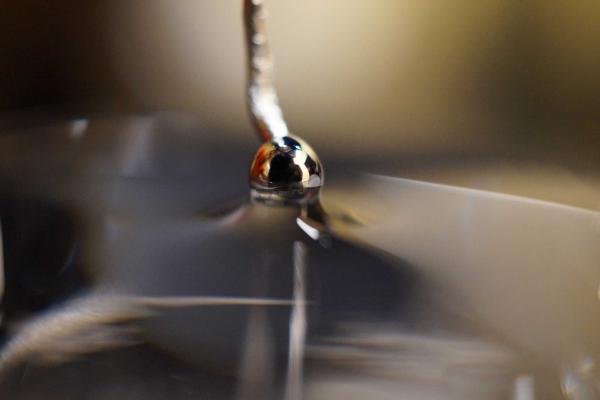
Exploring Worlds at Home
James Xie
The Queen's Space Engineering Team constructs a Mars rover each year to compete at the international University Rover Challenge in Utah. QSET brings together over 40 students from engineering, science, commerce, and the arts to design, build, and operate the rover. The rover can autonomously navigate treacherous landscapes, collect geological data, analyze samples, and remotely operate machinery. It can be seen here gazing out into the Utah desert. The rover is a culmination of countless hours of volunteer work and generous support from both Queen’s and industry partners. The team was proud to be the top team in Canada at the 2017 competition.
Location of photograph:
Mars Desert Research Station, Utah
Affiliation:
Undergraduate Student, Engineering Chemistry
Submission Year:
2017-18
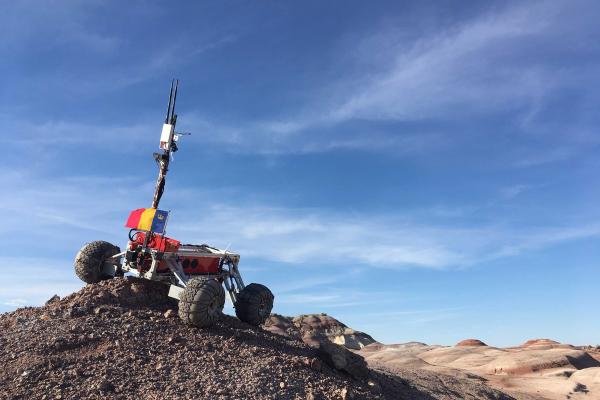
Coded, I Am
Stéfy McKnight
"Coded, I Am" is part of a larger research creation project that looks at preemptive surveillance strategies in North America. It is a self-portrait of an artist immersed in tattoo QR codes. The QR codes – when scanned – direct the viewer to Google Earth images of CSIS and NSA intelligence sites. The photograph not only shows an artist absorbed by her research, but it is a representation of how users rely on third party sites such as Google Earth in their everyday lives, regardless of the risk of data mining and surveillance. The codes shift the surveillance gaze by giving viewers the tools to look at the institutions that are normally doing the ‘surveilling’.
Location of photograph:
Kingston, Ontario
Affiliation:
Graduate Student, Cultural Studies
Submission Year:
2015-16

Borders. What borders?
John McGarry
The iconic Turkish Cypriot leader, Rauf Denktash, once remarked that “the only thing Cypriot is the donkey”. He wanted to underline that Cyprus was permanently divided between Turkish Cypriots and Greek Cypriots. He was wrong of course, as this photo from Cyprus’s Apostolos Andreas Monastery shows. There are also 'lots' of Cypriot cats who can wander freely between the Turkish and Greek zones in spite of the barbed wire and thousands of armed soldiers. These are “vanguard felines”. My work on power-sharing in Cyprus is aimed at helping their two-legged counterparts to follow in their wake.
Location of photograph:
Apostolos Andreas Monastery, North-east Cyprus
Affiliation:
Faculty, Political Studies
Submission Year:
2015-16

Leaving home
Eric Y Lian
My focus is cancer cell invasion and migration. This spheroid of cells is embedded in a 3D protein matrix and fluorescently stained for 3 proteins. Individual cells can be seen radiating away on all sides. The cells use integrin (red) and actin (green) to pull on the protein matrix and move, while cadherin (blue), binds and holds cells together within the spheroid. Cadherin normally holds clumps of cells together and allows them to form structures such as tissues and organs. This picture shows how invading cells lose their cadherin and express large amounts of integrin and actin, and it demonstrates some of the protein expression changes that cancer cells undergo which allow them to invade away from a tumour.
Location of photograph:
A microscope slide
Affiliation:
PhD Student, Pathology and Molecular Medicine
Submission Year:
2015-16
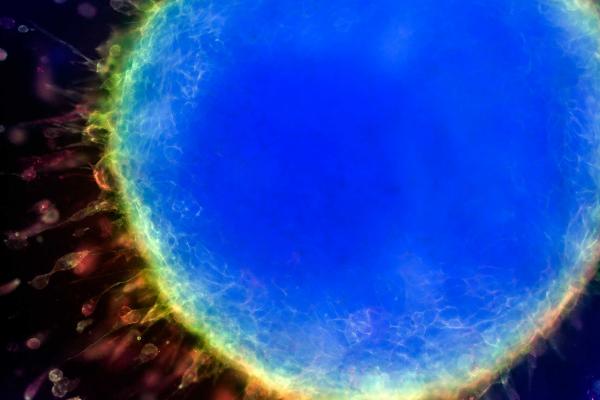
Twitter description:
#QueensuResearch | Queen's Art of Research photo contest is an opportunity for Queen’s faculty, students, staff, and alumni to showcase their research, scholarly, and artistic work.
Facebook description:
#QueensuResearch | Queen's Art of Research photo contest is an opportunity for Queen’s faculty, students, staff, and alumni to showcase their research, scholarly, and artistic work.

![[Art of Research photo by Fei Chen]](https://www.queensu.ca/research/sites/all/modules/contrib/lazyloader/image_placeholder.gif)
![[4 winning images from the 2020 Art of Research photo contest]](/research/sites/default/files/assets/20220607_173459463_iOS.png)
![[4 winning images from the 2022 Art of Research photo contest]](/research/sites/default/files/assets/news_story/Collage%20for%20Research%20Website_1080x1080.jpg)